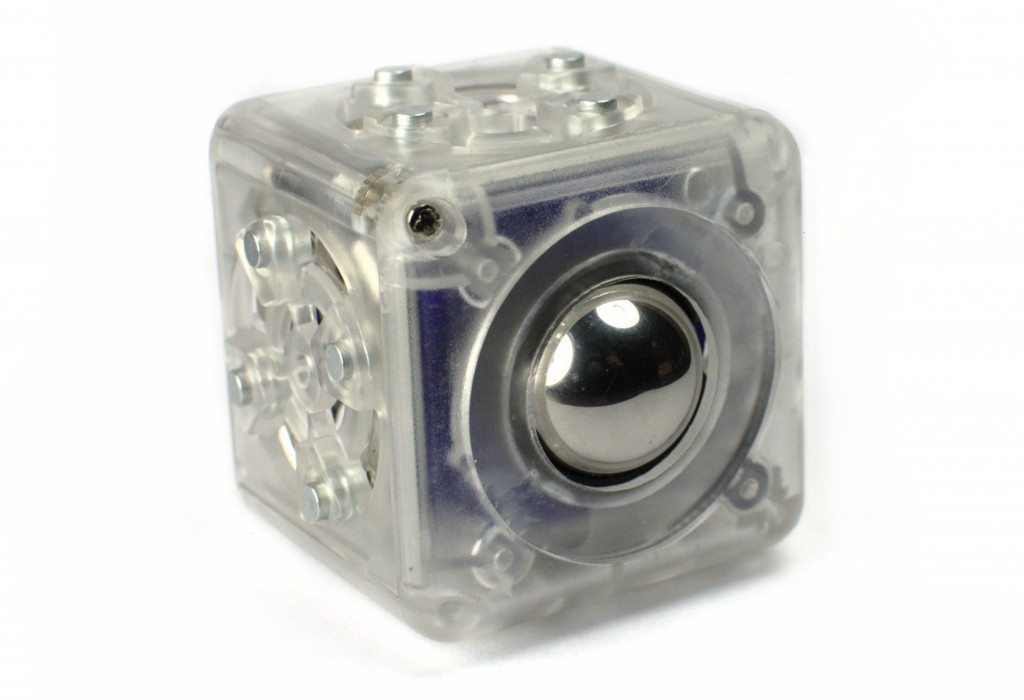Indeed you can! Do you know what a Turing Machine is? It’s a type of a computer, or, well, it’s a model of a computer. A simplified computer, with a memory tape and a read/write head that moves back and forth along the tape. It’s a funny little type of a computer, but it’s interesting in that with a Turing Machine, you can do any kind of digital computation that we can think of. Maybe not in a super optimized fashion, but… LOOK! Here’s a Turing Machine made with Cubelets and some LEGO bricks:
This construction was built by Genaro J. Martínez and students and collaborators at ALIROB (Artificial Life Robotics Lab) in Mexico. I think it’s brilliant. There’s a web site with a few more videos and all of the code has been published there too. You’ll see a ton of neat little programming features in these robots: Rotate Cubelets, for example, can only be controlled by specifying a speed, not a position. Check out how they use a distance Cubelet as a “stop” to recalibrate the little swinging arm after each swing.
Most of the Cubelets we make end up in elementary or middle school classrooms. So we spend a lot of time working on making Cubelets accessible, educational, and intriguing: focusing on the low-threshold aspects more than the high-ceiling aspects. It’s nice to be reminded that Cubelets are actually a universal computational material, a medium, capable of supporting some pretty advanced thought experiments.
Tag Archives: Cubelet hacking
As a new member of the modrobotics team, part of my fun is hacking together new and exciting Cubelets! Over the coming weeks and months, I’ll be posting some of our behind-the-scenes Cubelet hacks we’re playing with here in the lab. Any of these could end up as production Cubelets, especially if you make your desires heard.
We have a backlist of new ideas, but we’ve also got eyes on our forum for suggestions, which is exactly where the first idea in this series came from: the roller Cubelet. (Thank you to Michael Tarr for the suggestion!)
 After getting our hands on a roller ball and housing, we heisted a rotate block shell which had an appropriate size opening. After 45 minutes of running up and down from computer to the laser cutter and juggling little screws with a couple drops of super glue for good measure, we have the result you see here. The ball sticks down the same amount as the drive blocks to make a low friction omni-directional point of contact with the ground. Stable robots are happy robots!
More Cubelet hacks are coming! Stay tuned and flip over to the forum if you have any Cubelets you want us to make.
After getting our hands on a roller ball and housing, we heisted a rotate block shell which had an appropriate size opening. After 45 minutes of running up and down from computer to the laser cutter and juggling little screws with a couple drops of super glue for good measure, we have the result you see here. The ball sticks down the same amount as the drive blocks to make a low friction omni-directional point of contact with the ground. Stable robots are happy robots!
More Cubelet hacks are coming! Stay tuned and flip over to the forum if you have any Cubelets you want us to make.
 After getting our hands on a roller ball and housing, we heisted a rotate block shell which had an appropriate size opening. After 45 minutes of running up and down from computer to the laser cutter and juggling little screws with a couple drops of super glue for good measure, we have the result you see here. The ball sticks down the same amount as the drive blocks to make a low friction omni-directional point of contact with the ground. Stable robots are happy robots!
More Cubelet hacks are coming! Stay tuned and flip over to the forum if you have any Cubelets you want us to make.
After getting our hands on a roller ball and housing, we heisted a rotate block shell which had an appropriate size opening. After 45 minutes of running up and down from computer to the laser cutter and juggling little screws with a couple drops of super glue for good measure, we have the result you see here. The ball sticks down the same amount as the drive blocks to make a low friction omni-directional point of contact with the ground. Stable robots are happy robots!
More Cubelet hacks are coming! Stay tuned and flip over to the forum if you have any Cubelets you want us to make. 
